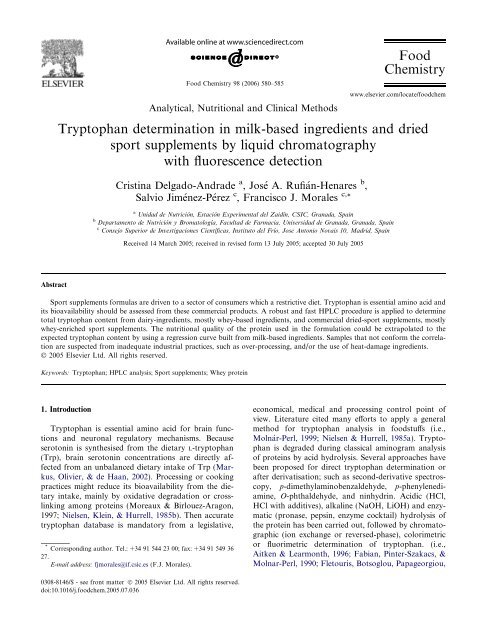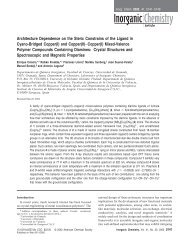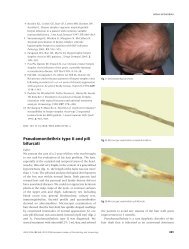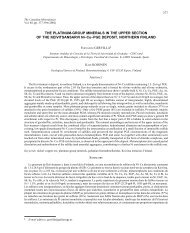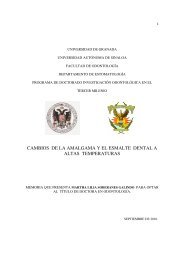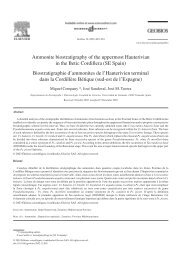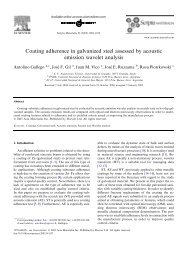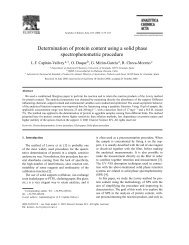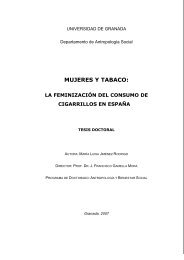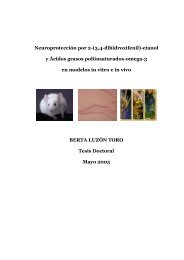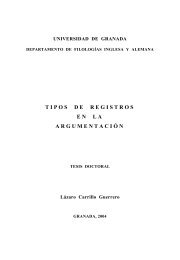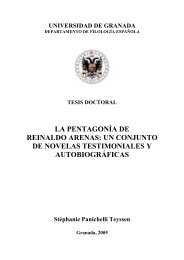Tryptophan determination in milk-based ingredients and dried sport ...
Tryptophan determination in milk-based ingredients and dried sport ...
Tryptophan determination in milk-based ingredients and dried sport ...
Create successful ePaper yourself
Turn your PDF publications into a flip-book with our unique Google optimized e-Paper software.
Abstract<br />
Analytical, Nutritional <strong>and</strong> Cl<strong>in</strong>ical Methods<br />
<strong>Tryptophan</strong> <strong>determ<strong>in</strong>ation</strong> <strong>in</strong> <strong>milk</strong>-<strong>based</strong> <strong>in</strong>gredients <strong>and</strong> <strong>dried</strong><br />
<strong>sport</strong> supplements by liquid chromatography<br />
with fluorescence detection<br />
Crist<strong>in</strong>a Delgado-Andrade a , José A. Rufián-Henares b ,<br />
Salvio Jiménez-Pérez c , Francisco J. Morales c, *<br />
a Unidad de Nutrición, Estación Experimental del Zaidín, CSIC, Granada, Spa<strong>in</strong><br />
b Departamento de Nutrición y Bromatología, Facultad de Farmacia, Universidad de Granada, Granada, Spa<strong>in</strong><br />
c Consejo Superior de Investigaciones Científicas, Instituto del Frío, Jose Antonio Novais 10, Madrid, Spa<strong>in</strong><br />
Received 14 March 2005; received <strong>in</strong> revised form 13 July 2005; accepted 30 July 2005<br />
Sport supplements formulas are driven to a sector of consumers which a restrictive diet. <strong>Tryptophan</strong> is essential am<strong>in</strong>o acid <strong>and</strong><br />
its bioavailability should be assessed from these commercial products. A robust <strong>and</strong> fast HPLC procedure is applied to determ<strong>in</strong>e<br />
total tryptophan content from dairy-<strong>in</strong>gredients, mostly whey-<strong>based</strong> <strong>in</strong>gredients, <strong>and</strong> commercial <strong>dried</strong>-<strong>sport</strong> supplements, mostly<br />
whey-enriched <strong>sport</strong> supplements. The nutritional quality of the prote<strong>in</strong> used <strong>in</strong> the formulation could be extrapolated to the<br />
expected tryptophan content by us<strong>in</strong>g a regression curve built from <strong>milk</strong>-<strong>based</strong> <strong>in</strong>gredients. Samples that not conform the correlation<br />
are suspected from <strong>in</strong>adequate <strong>in</strong>dustrial practices, such as over-process<strong>in</strong>g, <strong>and</strong>/or the use of heat-damage <strong>in</strong>gredients.<br />
Ó 2005 Elsevier Ltd. All rights reserved.<br />
Keywords: <strong>Tryptophan</strong>; HPLC analysis; Sport supplements; Whey prote<strong>in</strong><br />
1. Introduction<br />
Food Chemistry 98 (2006) 580–585<br />
<strong>Tryptophan</strong> is essential am<strong>in</strong>o acid for bra<strong>in</strong> functions<br />
<strong>and</strong> neuronal regulatory mechanisms. Because<br />
seroton<strong>in</strong> is synthesised from the dietary L-tryptophan<br />
(Trp), bra<strong>in</strong> seroton<strong>in</strong> concentrations are directly affected<br />
from an unbalanced dietary <strong>in</strong>take of Trp (Markus,<br />
Olivier, & de Haan, 2002). Process<strong>in</strong>g or cook<strong>in</strong>g<br />
practices might reduce its bioavailability from the dietary<br />
<strong>in</strong>take, ma<strong>in</strong>ly by oxidative degradation or crossl<strong>in</strong>k<strong>in</strong>g<br />
among prote<strong>in</strong>s (Moreaux & Birlouez-Aragon,<br />
1997; Nielsen, Kle<strong>in</strong>, & Hurrell, 1985b). Then accurate<br />
tryptophan database is m<strong>and</strong>atory from a legislative,<br />
*<br />
Correspond<strong>in</strong>g author. Tel.: +34 91 544 23 00; fax: +34 91 549 36<br />
27.<br />
E-mail address: fjmorales@if.csic.es (F.J. Morales).<br />
0308-8146/$ - see front matter Ó 2005 Elsevier Ltd. All rights reserved.<br />
doi:10.1016/j.foodchem.2005.07.036<br />
Food<br />
Chemistry<br />
www.elsevier.com/locate/foodchem<br />
economical, medical <strong>and</strong> process<strong>in</strong>g control po<strong>in</strong>t of<br />
view. Literature cited many efforts to apply a general<br />
method for tryptophan analysis <strong>in</strong> foodstuffs (i.e.,<br />
Molnár-Perl, 1999; Nielsen & Hurrell, 1985a). <strong>Tryptophan</strong><br />
is degraded dur<strong>in</strong>g classical am<strong>in</strong>ogram analysis<br />
of prote<strong>in</strong>s by acid hydrolysis. Several approaches have<br />
been proposed for direct tryptophan <strong>determ<strong>in</strong>ation</strong> or<br />
after derivatisation; such as second-derivative spectroscopy,<br />
p-dimethylam<strong>in</strong>obenzaldehyde, p-phenylenediam<strong>in</strong>e,<br />
O-phthaldehyde, <strong>and</strong> n<strong>in</strong>hydr<strong>in</strong>. Acidic (HCl,<br />
HCl with additives), alkal<strong>in</strong>e (NaOH, LiOH) <strong>and</strong> enzymatic<br />
(pronase, peps<strong>in</strong>, enzyme cocktail) hydrolysis of<br />
the prote<strong>in</strong> has been carried out, followed by chromatographic<br />
(ion exchange or reversed-phase), colorimetric<br />
or fluorimetric <strong>determ<strong>in</strong>ation</strong> of tryptophan. (i.e.,<br />
Aitken & Learmonth, 1996; Fabian, P<strong>in</strong>ter-Szakacs, &<br />
Molnar-Perl, 1990; Fletouris, Botsoglou, Papageorgiou,
& Mantis, 1993; Hugli & Moore, 1972; Ng, Pascaud, &<br />
Pascaud, 1987; Slump, Flissebaalje, & Haaksman,<br />
1991). Thus, depend<strong>in</strong>g on their structures, <strong>milk</strong> prote<strong>in</strong>s<br />
exhibits a characteristic fluorescence emission spectrum<br />
def<strong>in</strong>ed by its maximum emission wavelength <strong>and</strong><br />
the tryptophan quantum yield (Friedman & Cuq,<br />
1988; Lakowicz, 1983). Recently, Rav<strong>in</strong>dran <strong>and</strong> Bryden<br />
(2005) have proposed a chromatographic method<br />
<strong>based</strong> on ion-exchange separation <strong>and</strong> post-column Ophthaldehyde<br />
derivatization.<br />
The high nutritive value of the whey prote<strong>in</strong>s is<br />
ma<strong>in</strong>ly due to their high content of essential am<strong>in</strong>o acids,<br />
such as tryptophan (147 mg Trp/g total nitrogen), as<br />
compared the wheat, beef, soy bean or eggs (FAO,<br />
1973). In this sense, whey-<strong>based</strong> <strong>sport</strong> supplements are<br />
ga<strong>in</strong><strong>in</strong>g popularity among consumers. Nowadays,<br />
health-care concepts are l<strong>in</strong>ked to well-be<strong>in</strong>g <strong>and</strong> social<br />
acceptance, apart from competition skills, such as<br />
body-builders. Intakes of prote<strong>in</strong>s, mostly from a dairy<br />
source, represent a high proportion of the total diet for<br />
this type of consumers. Then, it is necessary to ensure<br />
the high quality of the prote<strong>in</strong> consumed as well as their<br />
efficient biotransformation. Quality of whey prote<strong>in</strong>s<br />
used <strong>in</strong> the formulation is highly related to the technology<br />
applied for its production (Holt et al., 1999). Whey<br />
used for <strong>sport</strong> supplements could be grouped accord<strong>in</strong>g<br />
to the prote<strong>in</strong> content <strong>and</strong> technologies used. Whey prote<strong>in</strong><br />
concentrates (WPC) usually conta<strong>in</strong>s less than 25%<br />
of prote<strong>in</strong> <strong>and</strong> whey prote<strong>in</strong> isolates (WPI) usually conta<strong>in</strong>s<br />
more than 70% prote<strong>in</strong>. The addition of whey prote<strong>in</strong>s<br />
from whey powders <strong>in</strong>to food products has two<br />
goals, one nutritive (as dietary supplements) <strong>and</strong> the<br />
other technological (solubility, foam formation, gel formation,<br />
emulsion, water b<strong>in</strong>d<strong>in</strong>g, viscosity, etc.) (Morr<br />
& Ha, 1993). Concentrated whey powders that conta<strong>in</strong><br />
more than 80% prote<strong>in</strong>s are used <strong>in</strong> a wide range of food<br />
applications (<strong>in</strong>fant formula, health foods, <strong>and</strong> dr<strong>in</strong>ks)<br />
as nutritional <strong>and</strong> functional <strong>in</strong>gredients (Fox, 1989).<br />
The aims of this <strong>in</strong>vestigation were: (a) to develop a<br />
robust <strong>and</strong> cost-effective method for tryptophan analysis<br />
<strong>in</strong> dairy-<strong>based</strong> formulations; (b) to evaluate the levels of<br />
tryptophan <strong>in</strong> widely distributed <strong>sport</strong>-supplements as<br />
well as representative whey-<strong>based</strong> commercial prote<strong>in</strong>s<br />
used as <strong>in</strong>gredients.<br />
2. Materials <strong>and</strong> methods<br />
2.1. Reagents<br />
L-<strong>Tryptophan</strong> (Trp), bov<strong>in</strong>e serum album<strong>in</strong> (BSA)<br />
<strong>and</strong> 5-methyl-triptophan (M-Trp) were purchased from<br />
Sigma (Sigma Chemicals Co., St. Louis, MO, USA).<br />
Chloridric acid, sodium hydroxide, <strong>and</strong> acetonitrile of<br />
HPLC grade were from Merck (Darmstadt, Germany).<br />
All other chemicals used were of analytical purity.<br />
C. Delgado-Andrade et al. / Food Chemistry 98 (2006) 580–585 581<br />
2.2. Samples<br />
Representative samples of <strong>milk</strong>-<strong>based</strong> powder (<strong>in</strong>gredients<br />
n = 18, <strong>and</strong> formulas n = 16) were obta<strong>in</strong>ed directly<br />
from manufacturers (Tables 1 <strong>and</strong> 2). Most<br />
samples are directly marketed as supplied except for<br />
P12–P16 which were produced at <strong>in</strong>dustrial scale but<br />
not commercially distributed. Ingredients were distributed<br />
<strong>in</strong> WPC (whey prote<strong>in</strong> concentrate n = 4), WPI<br />
(whey prote<strong>in</strong> isolates n = 11) <strong>and</strong> calcium-case<strong>in</strong>ates<br />
(n = 3) accord<strong>in</strong>g to technical <strong>in</strong>formation supplied by<br />
manufacturers. Most of the f<strong>in</strong>al products (n = 12) have<br />
a prote<strong>in</strong> content higher than 60% (expressed <strong>in</strong> <strong>dried</strong><br />
weight). Products conta<strong>in</strong><strong>in</strong>g low proportions of nondairy<br />
prote<strong>in</strong>s, such as soy-prote<strong>in</strong> <strong>and</strong> egg-album<strong>in</strong><br />
were also <strong>in</strong>cluded <strong>in</strong> order to evaluate potential bias<br />
<strong>in</strong> dur<strong>in</strong>g the analysis. Two homogeneous portions were<br />
packed <strong>in</strong> plastic conta<strong>in</strong>ers sealed under vacuum, light<br />
protected to m<strong>in</strong>imize possible tryptophan oxidation<br />
<strong>and</strong> stored at 4 °C until analysed.<br />
2.3. Alkal<strong>in</strong>e hydrolysis procedure<br />
Samples (9–10 mg, 0.1 mg precision) were dissolved<br />
<strong>in</strong> 3 ml of 4 N sodium hydroxide <strong>and</strong> 150 ll 5-methyltryptophan<br />
(16 mg/100 ml) as <strong>in</strong>ternal st<strong>and</strong>ard was<br />
added. Hydrolysis tubes were sealed under nitrogen.<br />
Samples hydrolysed <strong>in</strong> an oven at 110 °C for 18 h. The<br />
hydrolysates were aerated <strong>and</strong> cooled at 4 °C. Then<br />
carefully acidified to a pH 6.5 with HCl, diluted to<br />
25 ml with sodium borate buffer (0.1 M, pH 9.0) <strong>and</strong> allowed<br />
to st<strong>and</strong> for 15 m<strong>in</strong>. Samples were centrifuged at<br />
Table 1<br />
Ingredients description <strong>and</strong> technical <strong>in</strong>formation supplied by<br />
manufacturers<br />
ID Prote<strong>in</strong> source Prote<strong>in</strong> (%) a<br />
Carbohydrates (%) a<br />
A WPC 35.0 n.d.<br />
B WPI 93.0 0.5<br />
C WPI 90.0 1.0<br />
D Hydrolysed-case<strong>in</strong> 86.0
582 C. Delgado-Andrade et al. / Food Chemistry 98 (2006) 580–585<br />
Table 2<br />
Formula description <strong>and</strong> technical <strong>in</strong>formation supplied by manufacturers<br />
ID Type Prote<strong>in</strong> source Prote<strong>in</strong> (%) a<br />
Carbohydrates (%) a<br />
P1 Commercial Ca-case<strong>in</strong>ate, WPC 50.0 41.6<br />
P2 Commercial WPC, WPI, hydrolysed-WPI 81.0 10.0<br />
P3 Commercial WPC, hydrolysed-WPC 21.8 69.0<br />
P4 Commercial WPI 76.0 11.0<br />
P5 Commercial Ca-case<strong>in</strong>ate, WPC 59.0 33.2<br />
P6 Commercial Ca-case<strong>in</strong>ate, WPI 88.0 4.0<br />
P7 Commercial Ca-case<strong>in</strong>ate, WPC 90.9 3.8<br />
P8 Commercial Ca-case<strong>in</strong>ate, WPC 18.0 78.0<br />
P9 Commercial WPC, WPI, hydrolysed egg album<strong>in</strong> 73.6 19.0<br />
P10 Commercial Ca-case<strong>in</strong>ate,WPC hydrolysed egg album<strong>in</strong> 92.4 6.1<br />
P11 Commercial WPI, hydrolysed egg album<strong>in</strong> 88.0 2.9<br />
P12 No-commercial Ca-case<strong>in</strong>ate, WPC n.d. n.d.<br />
P13 No-commercial Ca-case<strong>in</strong>ate, WPI n.d. n.d.<br />
P14 No-commercial Ca-case<strong>in</strong>ate, WPI n.d. n.d.<br />
P15 No-commercial WPI n.d. n.d.<br />
P16 No-commercial n.d. n.d. n.d.<br />
n.d., not declared. Prote<strong>in</strong> source. WPC, whey prote<strong>in</strong> concentrate; WPI, whey prote<strong>in</strong> isolate.<br />
a<br />
Data expressed as g/100 g of product.<br />
10,000g for 4 m<strong>in</strong> <strong>and</strong> supernatant filtered through<br />
0.2 lm nylon filter membrane <strong>in</strong>to HPLC vials. Trp<br />
losses dur<strong>in</strong>g hydrolysis were corrected by <strong>in</strong>ternal st<strong>and</strong>ard<br />
calculation, where the tryptophan contents were<br />
calculated by divid<strong>in</strong>g the area of the peak by the area<br />
of the <strong>in</strong>ternal st<strong>and</strong>ard <strong>and</strong> multiply<strong>in</strong>g this value by<br />
the weight of the <strong>in</strong>ternal st<strong>and</strong>ard <strong>and</strong> the response factor<br />
of tryptophan. Samples were hydrolysed <strong>in</strong><br />
quadruplicate.<br />
2.4. Instruments<br />
A Kontron Instruments (Milan, Italy) chromatographic<br />
system was used for tryptophan <strong>and</strong> methyltryptophan<br />
analysis, with a pump (MD-420), UV–vis<br />
detector (MD-432), spectrofluorimeter (SMF-25),<br />
refractive <strong>in</strong>dex (Erma, Inc., Tokyo, Japan) <strong>and</strong> a DT-<br />
450/MT-2 v.3.90 comput<strong>in</strong>g <strong>in</strong>tegrator connected to a<br />
PC.<br />
2.5. Determ<strong>in</strong>ation of tryptophan by reversed-phase liquid<br />
chromatography<br />
A degassed mobile phase was prepared with acetonitrile:water<br />
(25:75; v/v) conta<strong>in</strong><strong>in</strong>g 0.1% of trifluoroacetic<br />
acid <strong>and</strong> the flow rate was set at 1.0 ml/m<strong>in</strong>. An Excell<br />
ODS-2 S5 analytical column (25 · 0.40 cm, 5 lm, Tecknokroma,<br />
Barcelona, Spa<strong>in</strong>) was used. Column was<br />
ma<strong>in</strong>ta<strong>in</strong>ed at 32 °C dur<strong>in</strong>g analysis. Samples (20 ll)<br />
were <strong>in</strong>jected <strong>in</strong>to the column. <strong>Tryptophan</strong> <strong>and</strong><br />
methyl-tryptophan were detected at 280 <strong>and</strong> 340 nm<br />
for excitation <strong>and</strong> emission wavelengths, respectively.<br />
Retention times were 3.8 <strong>and</strong> 5.8 m<strong>in</strong> for tryptophan<br />
<strong>and</strong> methyl-tryptophan, respectively. Duplicate analysis<br />
of each hydrolysate was analysed.<br />
2.6. Total prote<strong>in</strong> content<br />
Samples (0.800–1.000 g) were heated to 1050 °C follow<strong>in</strong>g<br />
AOAC 992.15 (AOAC, 1995) <strong>in</strong> a LECO model<br />
FP-2000 (Leco Instruments, Madrid, Spa<strong>in</strong>) prote<strong>in</strong>/<br />
nitrogen analyser calibrated with EDTA (Dumas method).<br />
The nitrogen-to-prote<strong>in</strong> conversion factor considered<br />
was 6.38%. Results were expressed as grams of<br />
prote<strong>in</strong>/100 g of products.<br />
2.7. Statistical analysis of data<br />
Statistical analysis of data were performed by multiple<br />
analysis of variance follow<strong>in</strong>g a simple, balanced<br />
one-way model. StudentÕs t-test was used to compare<br />
means <strong>and</strong> the level of significance was set at 95%. Statgraphic<br />
v.2.0 software (Statistical Graphics Corp.,<br />
Rockville, MD, USA) was used.<br />
3. Results <strong>and</strong> discussion<br />
The repeatability of the Trp quantification was <strong>in</strong>vestigated<br />
by perform<strong>in</strong>g 12 <strong>determ<strong>in</strong>ation</strong>s at two different<br />
levels of the st<strong>and</strong>ards (2.35 <strong>and</strong> 9.40 lmol/l) spiked<br />
with M-Trp (160 mg/l). Residual st<strong>and</strong>ard deviations<br />
was found to be 1.3% (2.35 lmol/l, n = 12) <strong>and</strong> 1.68%<br />
(9.40 lmol/l, n = 12). Detection limit (DL, 0.46 lmol/l)<br />
<strong>and</strong> quantification limit (QL, 1.37 lmol/l) for Trp were<br />
determ<strong>in</strong>ed by the st<strong>and</strong>ard deviation approach <strong>in</strong> the<br />
estimated limit of quantification. Quantification limit<br />
was confirmed experimentally with 2.5-fold diluted sample<br />
P3 (1.62 lmol/l, RSD. 3.12%, n = 3).<br />
In order to validate the alkal<strong>in</strong>e hydrolysis procedure<br />
for Trp analysis to whey-<strong>based</strong> <strong>sport</strong> supplements <strong>and</strong>
Trp (nmol)<br />
40<br />
30<br />
20<br />
10<br />
corrected<br />
non-corrected<br />
0<br />
0 4 8 12 16 20 24<br />
heat<strong>in</strong>g time (h)<br />
Fig. 1. Stability of Trp dur<strong>in</strong>g alkal<strong>in</strong>e hydrolysis (empty symbol) <strong>and</strong><br />
Trp corrected with the recovery of M-Trp (full symbol). Error bars<br />
denote st<strong>and</strong>ard deviation from two <strong>in</strong>dependent analyses. Theoretical<br />
value is drawn as a dotted l<strong>in</strong>e.<br />
<strong>in</strong>gredients, several <strong>in</strong>vestigations were carried out. It<br />
was <strong>in</strong>vestigated the stability of free L-tryptophan <strong>in</strong><br />
4 M NaOH dur<strong>in</strong>g hydrolysis up to 24 h. Free Trp is<br />
most susceptible to degradation dur<strong>in</strong>g alkal<strong>in</strong>e hydrolysis.<br />
Fig. 1 shows Trp is rapidly degraded dur<strong>in</strong>g alkal<strong>in</strong>e<br />
hydrolysis from 19.2% (2 h) to 58.2% (24 h), but results<br />
rema<strong>in</strong>s constant if Trp area value is corrected by the M-<br />
Trp one. This evaluation agrees with reported by Nielsen<br />
<strong>and</strong> Hurrell (1985a).<br />
Accuracy of the analytical procedure was evaluated<br />
with bov<strong>in</strong>e serum album<strong>in</strong> which literature reports that<br />
conta<strong>in</strong>s two residues of Trp per molecule (Hugli &<br />
Moore, 1972). Fig. 2 shows the recovery of Trp residues<br />
from the prote<strong>in</strong> at different heat<strong>in</strong>g times <strong>in</strong> reproducibilility<br />
conditions. Hydrolysis times from 16 to 24 h<br />
were acceptable, <strong>and</strong> 18 h (1.93 ± 0.102 Trp/BSA molar<br />
ratio) were selected for further analysis. The 96.5% of<br />
the expected Trp was released <strong>and</strong> efficiently measured<br />
from BSA. Heat<strong>in</strong>g times higher than 18 h provides<br />
higher uncerta<strong>in</strong>ty on the reported Trp value <strong>and</strong> lower<br />
precision for the M-Trp recoveries, but higher Trp<br />
recoveries. Fig. 3 shows Trp <strong>and</strong> M-Trp were resolved<br />
at basel<strong>in</strong>e by apply<strong>in</strong>g the procedure to different type<br />
of samples (<strong>in</strong>gredients <strong>and</strong> commercial products).<br />
There was not detected <strong>in</strong>terference from other compounds<br />
which might be present <strong>in</strong> the sample. This<br />
observation was confirmed by spik<strong>in</strong>g recovery studies<br />
performed on a commercial sample with two levels of<br />
tryptophan Trp concentration (data not shown). The<br />
recovery of tryptophan <strong>in</strong> sample P15 was 93.4% <strong>and</strong><br />
96.6% at two levels of Trp concentration.<br />
A homogeneity study of the test sample was also performed<br />
by tak<strong>in</strong>g portions from different part of the<br />
conta<strong>in</strong>er. Residual st<strong>and</strong>ard deviation was found to<br />
be 2.05% for eight <strong>in</strong>dependent analysis of sample P2<br />
(0.487 ± 0.010 g Trp/100 g prote<strong>in</strong>). It was calculated<br />
C. Delgado-Andrade et al. / Food Chemistry 98 (2006) 580–585 583<br />
Trp / BSA (molar ratio)<br />
2.0<br />
1.5<br />
1.0<br />
0.5<br />
0.0<br />
0 4 8 12 16 20 24<br />
heat<strong>in</strong>g time (h)<br />
Fig. 2. Determ<strong>in</strong>ation of Trp <strong>in</strong> pure bov<strong>in</strong>e serum album<strong>in</strong> (2 Trp<br />
residues per molecule) dur<strong>in</strong>g alkal<strong>in</strong>e hydrolysis. Trp values are<br />
corrected with the recovery of M-Trp. Error bars denote st<strong>and</strong>ard<br />
deviation from two <strong>in</strong>dependent analyses. Theoretical value is drawn<br />
as a dotted l<strong>in</strong>e.<br />
Fig. 3. Classical chromatogram profile of Trp analysis form alkal<strong>in</strong>e<br />
digestion: (1) sample A1 (WPC-<strong>in</strong>gredient); (2) sample P5 (commercial<br />
<strong>sport</strong> formula); (3) sample F1 (WPI-<strong>in</strong>gredient). 1.21, 0.90 <strong>and</strong> 1.89 g<br />
Trp/100 g prote<strong>in</strong> for samples A1, P5, <strong>and</strong> F1, respectively.<br />
an M-Trp average recovery of 94.7 ± 5.53% (n = 8).<br />
Table 3 reported the study of precision on sample<br />
P-15. Sample was analysed on three non-consecutive<br />
days to determ<strong>in</strong>e the precision of the method. It was<br />
evaluated repeatability <strong>and</strong> <strong>in</strong>termediate precision or<br />
reproducibility. Results show a good <strong>in</strong>termediate precision<br />
of 9.30% for Trp <strong>and</strong> an average M-Trp recovery of<br />
99.1%.<br />
The relationship between tryptophan content <strong>and</strong><br />
prote<strong>in</strong> content of <strong>in</strong>gredients <strong>and</strong> whey-<strong>based</strong> <strong>sport</strong><br />
supplements was studied (Fig. 4). It is noteworthy to<br />
keep <strong>in</strong> m<strong>in</strong>d that companies did not supply the full
584 C. Delgado-Andrade et al. / Food Chemistry 98 (2006) 580–585<br />
Table 3<br />
Precision study (repeatability <strong>and</strong> <strong>in</strong>termediate precision) of tryptophan <strong>determ<strong>in</strong>ation</strong> (g/100 g product) <strong>in</strong> a whey prote<strong>in</strong> <strong>sport</strong> supplement<br />
conta<strong>in</strong><strong>in</strong>g 81.3 g of prote<strong>in</strong> per 100 g of product<br />
Sample IS recovery (%) Average Trp content<br />
(g/100 g product)<br />
composition of the unprocessed formulas. Then, it was<br />
not able to evaluate the f<strong>in</strong>al Trp conta<strong>in</strong> directly form<br />
the <strong>in</strong>gredients <strong>in</strong> order to correlated with the Trp content<br />
of the processed formula. A regression analysis was<br />
carried out with<strong>in</strong> the laboratory characterised <strong>in</strong>gredients<br />
(mostly whey prote<strong>in</strong>s). Tested <strong>in</strong>gredients are<br />
widely applied for body build<strong>in</strong>g formulas at commercial<br />
scale. Ingredients were grouped <strong>in</strong> WPC (total prote<strong>in</strong><br />
content lower than 25%) <strong>and</strong> WPI (total prote<strong>in</strong><br />
content higher than 70%). It was observed a significant<br />
correlation (p < 0.01) between Trp (g/100 g of product)<br />
<strong>and</strong> prote<strong>in</strong> content (g/100 g of product). Obviously, a<br />
high correlation is expected for pure mixture of raw prote<strong>in</strong><br />
but the regression agreement could be reduced<br />
accord<strong>in</strong>g to the extent of the heat load applied.<br />
As previously mentioned, WPC <strong>and</strong> WPI production<br />
have different process<strong>in</strong>g conditions where more severe<br />
heat load is applied to WPC. Whey prote<strong>in</strong>s are thermolabile<br />
be<strong>in</strong>g a-la > b-lg > BSA classified <strong>in</strong> order of thermostability<br />
(Fox, 1989). For <strong>in</strong>stance, whey prote<strong>in</strong>s<br />
<strong>dried</strong> by roller procedure <strong>in</strong>stead of spray will be affected<br />
with higher denaturation rates (Morales, Romero, &<br />
Jiménez-Pérez, 2000). On the other h<strong>and</strong>, WPC conta<strong>in</strong>s<br />
M<strong>in</strong>imum<br />
(g/100 g product)<br />
Maximum<br />
(g/100 g product)<br />
RSD (%) n<br />
Day-1 P-15 101.8 ± 2.13 0.910 ± 0.0025 0.873 0.954 2.73 8<br />
Day-2 P-15 98.8 ± 1.56 1.093 ± 0.0158 2<br />
Day-3 P-15 96.6 ± 1.77 0.979 ± 0.1027 2<br />
Intra-day P-15 99.1 ± 2.61 0.994 ± 0.0924 0.910 1.093 9.30 3<br />
IS, <strong>in</strong>ternal st<strong>and</strong>ard;, n, number of <strong>in</strong>dependent analysis. All samples analysed by duplicate.<br />
Trp (g/100g product)<br />
2.0<br />
1.8<br />
1.6<br />
1.4<br />
1.2<br />
1.0<br />
0.8<br />
0.6<br />
0.4<br />
0.2<br />
WPC<br />
P8<br />
P3<br />
P1<br />
P5<br />
P16<br />
WPI<br />
P2<br />
P7<br />
0.0<br />
0 25 50 75<br />
100<br />
prote<strong>in</strong> (g/100g product)<br />
Fig. 4. Relationship between Trp content (g/100 g of product) <strong>and</strong><br />
prote<strong>in</strong> content (g/100 g product) for <strong>in</strong>gredients (WPC <strong>and</strong> WPI), <strong>and</strong><br />
commercial samples. Dotted l<strong>in</strong>es <strong>in</strong>dicate limits of confidence at 95%.<br />
Solid l<strong>in</strong>e <strong>in</strong>dicates correlation for whey-<strong>based</strong> <strong>in</strong>gredients. Ingredients<br />
(empty symbol), commercial formulas (solid symbols). Error bars<br />
denote st<strong>and</strong>ard deviation from two <strong>in</strong>dependent analyses.<br />
G<br />
F<br />
T<br />
B<br />
higher lactose proportions (6–8%) compared with WPI<br />
(
measured one, except for sample P7 with a 8.6% of prote<strong>in</strong><br />
lower than measured. Differences among declarated<br />
prote<strong>in</strong> content <strong>and</strong> measured prote<strong>in</strong> content was lower<br />
than 2% <strong>and</strong> 4.5% for <strong>in</strong>gredients <strong>and</strong> samples,<br />
respectively.<br />
In conclusion, a rapid <strong>and</strong> robust methodology is described<br />
for analysis of tryptophan <strong>in</strong> whey-<strong>based</strong> <strong>sport</strong><br />
supplements. The procedure is not subject to <strong>in</strong>terference<br />
by other molecules <strong>in</strong> whey-<strong>based</strong> <strong>sport</strong> supplements<br />
<strong>and</strong> can by applied rout<strong>in</strong>ely. The nutritional<br />
quality of the prote<strong>in</strong> used <strong>in</strong> the formulation could be<br />
extrapolated by the expected tryptophan content by<br />
us<strong>in</strong>g a regression curve built from <strong>milk</strong>-<strong>based</strong> commercial<br />
<strong>in</strong>gredients. Then, the possible over-process<strong>in</strong>g practices<br />
could be detected from the lack of relationship<br />
between the Trp content <strong>and</strong> total prote<strong>in</strong> content of<br />
the commercial samples.<br />
Acknowledgements<br />
Dolores Gómez is <strong>in</strong>debted by technical assistance.<br />
This research was supported by two postdoctoral grants<br />
from Consejeria de Educacion y Ciencia (Junta de<br />
Andalucia) <strong>and</strong> by the Spanish M<strong>in</strong>istry of Science<br />
<strong>and</strong> Technology under Project AGL20001452.<br />
References<br />
Association of Official Analytical Chemists (1995). In: Official Methods<br />
of the Association of Official Analytical Chemists, 16th ed.<br />
AOAC. Wash<strong>in</strong>gton DC, pp. 3–6.<br />
Aitken, A., & Learmonth, M. (1996). Quantitation of tryptophan <strong>in</strong><br />
prote<strong>in</strong>s. In J. Walker (Ed.), The prote<strong>in</strong> protocols h<strong>and</strong>book<br />
(pp. 29–31). Totowa, NJ: Humana Press.<br />
Fabian, V., P<strong>in</strong>ter-Szakacs, M., & Molnar-Perl, I. (1990). Gas<br />
chromatography of tryptophan together with other am<strong>in</strong>o acids<br />
<strong>in</strong> hydrochloric acid hydrolysates. Journal of Chromatography, 520,<br />
193–199.<br />
FAO (1973). Am<strong>in</strong>o acid content of foods. FAO Nutritional Studies,<br />
No. 24. Rome: FAO.<br />
Fletouris, D. J., Botsoglou, N. A., Papageorgiou, G. E., & Mantis, A.<br />
J. (1993). Rapid <strong>determ<strong>in</strong>ation</strong> of tryptophan <strong>in</strong> <strong>in</strong>tact prote<strong>in</strong>s by<br />
derivative spectrophotometry. Journal of the AOAC International,<br />
76, 1168–1173.<br />
Fox, P. F. (1989). The <strong>milk</strong> prote<strong>in</strong> system. In Development <strong>in</strong> dairy<br />
chemistry 4, functional <strong>milk</strong> prote<strong>in</strong>s. New York, USA: Elsevier.<br />
C. Delgado-Andrade et al. / Food Chemistry 98 (2006) 580–585 585<br />
Friedman, M., & Cuq, J. L. (1988). Chemistry, analysis, nutritional<br />
value, <strong>and</strong> toxicology of tryptophan <strong>in</strong> food: a review. Journal of<br />
Agricultural <strong>and</strong> Food Chemistry, 36, 1079–1093.<br />
Holt, C., McPhail, D., Nevison, I., Nyl<strong>and</strong>er, T., Otte, J., Ipsen, R. H.,<br />
et al. (1999). Apparent chemical composition of n<strong>in</strong>e commercial<br />
or semi-commercial whey prote<strong>in</strong> concentrates isolates <strong>and</strong> fractions.<br />
International Journal of Food Science <strong>and</strong> Technology, 34,<br />
543–556.<br />
Hugli, T. E., & Moore, S. (1972). Determ<strong>in</strong>ation of the tryptophan<br />
content of prote<strong>in</strong>s by ion exchange chromatography of alkal<strong>in</strong>e<br />
hydrosylates. Journal of Biological Chemistry, 247, 2828–2834.<br />
Lakowicz, J. R. (1983). Prote<strong>in</strong> fluorescence. In Pr<strong>in</strong>ciples of fluorescence<br />
spectroscopy. New York, USA: Plenum Press.<br />
Markus, C. R., Olivier, B., & de Haan, E. H. F. (2002). Whey prote<strong>in</strong><br />
rich <strong>in</strong> a-lactalbum<strong>in</strong> <strong>in</strong>creases the ration of plasma tryptophan to<br />
the sum of the other large neutral am<strong>in</strong>o acids <strong>and</strong> improves<br />
cognitive performance <strong>in</strong> stress-vulnerable subjects. American<br />
Journal of Cl<strong>in</strong>ical Nutrition, 75, 1051–1056.<br />
Molnár-Perl, I. (1999). Advances <strong>in</strong> the analysis of tryptophan <strong>and</strong> its<br />
related compounds by chromatography. Advances <strong>in</strong> Experimental<br />
Medic<strong>in</strong>e <strong>and</strong> Biology, 467, 801–806.<br />
Morales, F. J., Romero, C., & Jiménez-Pérez, S. (2000). Characterization<br />
of <strong>in</strong>dustrial processed <strong>milk</strong> by analysis of heat-<strong>in</strong>duced<br />
changes. International Journal of Food Science <strong>and</strong> Technology, 35,<br />
193–200.<br />
Moreaux, V., & Birlouez-Aragon, I. (1997). Degradation of tryptophan<br />
<strong>in</strong> heated b-lactoglobul<strong>in</strong>–lactose mixtures is associated with<br />
<strong>in</strong>tense Maillard reaction. Journal of Agricultural <strong>and</strong> Food<br />
Chemistry, 45, 1905–1910.<br />
Morr, C. V., & Foeged<strong>in</strong>g, E. A. (1990). Composition <strong>and</strong> functionality<br />
of commercial whey <strong>and</strong> <strong>milk</strong> prote<strong>in</strong> concentrates <strong>and</strong><br />
isolates: A status report. Food Technology, 44, 100–112.<br />
Morr, C. V., & Ha, E. Y. W. (1993). Whey prote<strong>in</strong> concentrates <strong>and</strong><br />
isolates: process<strong>in</strong>g <strong>and</strong> functional properties. Critical Reviews <strong>in</strong><br />
Food Science <strong>and</strong> Nutrition, 33, 431–476.<br />
Ng, L. T., Pascaud, A., & Pascaud, M. (1987). Hydrochloric acid<br />
hydrolysis of prote<strong>in</strong>s <strong>and</strong> <strong>determ<strong>in</strong>ation</strong> of tryptophan by reversed<br />
phase high-performance liquid chromatography. Analytical Biochemistry,<br />
167, 47–52.<br />
Nielsen, H. K., & Hurrell, R. F. (1985a). <strong>Tryptophan</strong> <strong>determ<strong>in</strong>ation</strong> of<br />
food prote<strong>in</strong>s by HPLC after alkal<strong>in</strong>e hydrolysis. Journal of the<br />
Science of Food <strong>and</strong> Agriculture, 36, 893–907.<br />
Nielsen, H. K., Kle<strong>in</strong>, A., & Hurrell, R. F. (1985b). Stability of<br />
tryptophan dur<strong>in</strong>g food process<strong>in</strong>g <strong>and</strong> storage. 2. A comparison<br />
of methods used for the measurement of tryptophan losses <strong>in</strong><br />
processed foods. British Journal of Nutrition, 53, 293–300.<br />
Rav<strong>in</strong>dran, G., & Bryden, W. L. (2005). <strong>Tryptophan</strong> <strong>determ<strong>in</strong>ation</strong> <strong>in</strong><br />
prote<strong>in</strong>s <strong>and</strong> feedstuffs by ion exchange chromatography. Food<br />
Chemistry, 89, 309–314.<br />
Simat, T. J., & Ste<strong>in</strong>hart, H. (1998). Oxidation of free tryptophan <strong>and</strong><br />
tryptophan residues <strong>in</strong> peptides <strong>and</strong> prote<strong>in</strong>s. Journal of Agricultural<br />
<strong>and</strong> Food Chemistry, 46, 490–498.<br />
Slump, P., Flissebaalje, T. D., & Haaksman, I. K. (1991). <strong>Tryptophan</strong><br />
<strong>in</strong> food prote<strong>in</strong>s: a comparison of two hydrolytic procedures.<br />
Journal of the Science of Food <strong>and</strong> Agriculture, 55, 493–496.


